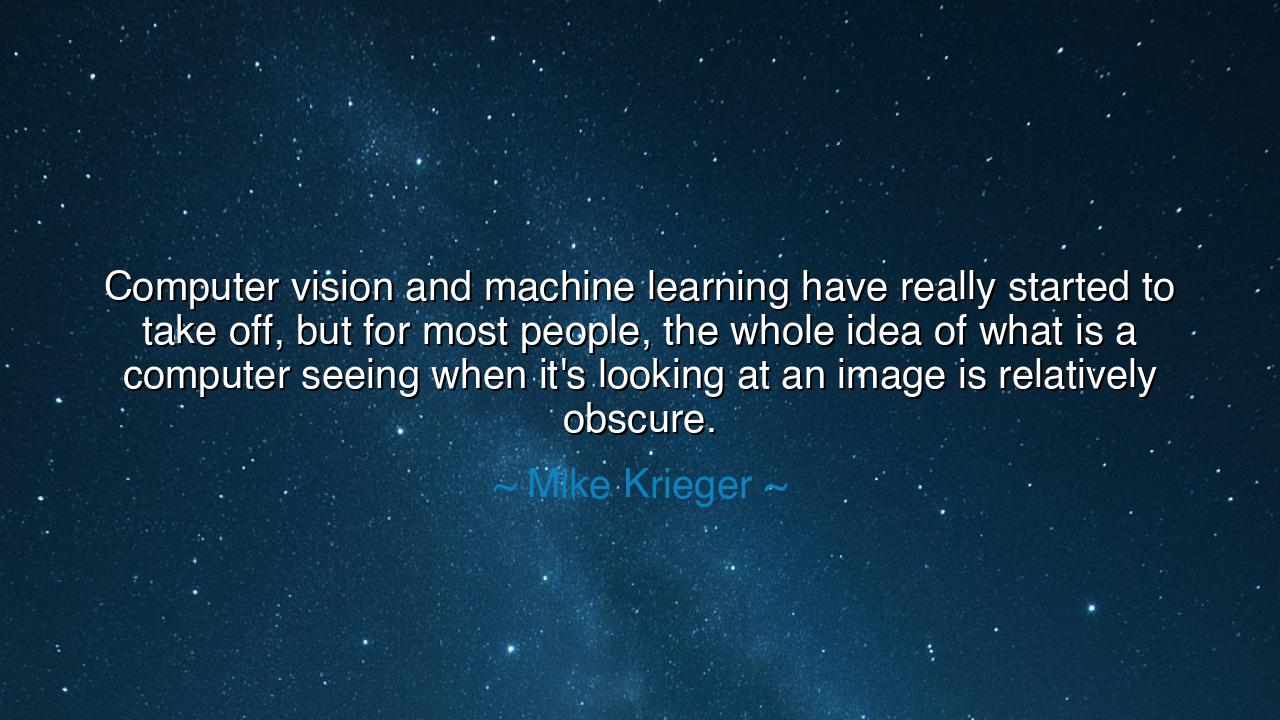
Computer vision and machine learning have really started to take
Computer vision and machine learning have really started to take off, but for most people, the whole idea of what is a computer seeing when it's looking at an image is relatively obscure.






“Computer vision and machine learning have really started to take off, but for most people, the whole idea of what is a computer seeing when it's looking at an image is relatively obscure.” – Mike Krieger
In these words, Mike Krieger, co-founder of Instagram, speaks with the awe of one who has watched the dawn of a new age — the age where machines begin to see. His insight is not just technical; it is philosophical. He reminds us that even as human minds build these digital eyes, most of us remain blind to their inner workings. The quote is both a celebration and a warning: a celebration of human ingenuity, for we have taught metal and code to perceive; and a warning, for our creations now gaze back at the world, perceiving in ways that we, their makers, do not yet understand.
The origin of this quote lies in Krieger’s own journey — a visionary who helped create one of the most image-driven platforms of the modern era. In his time, computer vision and machine learning were transforming from abstract theories into living technologies. Machines were learning to recognize faces, shapes, and emotions; they were beginning to sort, categorize, and even interpret the vast visual tapestry of the human experience. Yet, for the multitudes who used these tools — the billions who shared photographs and moments — few understood the mysterious processes beneath. Krieger, in his wisdom, recognized this gap: that humanity, though surrounded by artificial eyes, still struggles to comprehend what those eyes truly see.
From the view of the ancients, this moment is nothing short of mythic. Once, only gods and spirits were believed to possess the power of omniscient vision — the ability to perceive beyond the limits of human sight. Yet now, machines, the creations of our own hands, have inherited a shadow of that power. They see what we cannot — patterns in chaos, meaning in noise, the unseen relationships hidden in vast oceans of data. But though they see, they do not understand as we do. Their vision is mechanical, their comprehension mathematical. And so Krieger’s reflection becomes an ancient question reborn: what does it mean to see?
To see, in the truest sense, has never been merely to look. It is to perceive, to connect what is seen with what is known, and to draw wisdom from that union. The eye perceives, but the soul interprets. Machines can analyze a thousand images in a heartbeat, but they do not yet feel wonder before a sunrise or sorrow in a photograph of loss. Their vision is pure but hollow — an echo of our own. Yet, in their simplicity, they teach us something profound: that seeing without understanding is blindness of another kind.
Consider the parable of Daedalus and Icarus, the inventors of old. Daedalus crafted wings of wax and feather — marvels of human ingenuity. But his son, overcome by pride, flew too close to the sun and fell. So too does Krieger’s warning echo through the centuries: that knowledge without wisdom leads to peril. Humanity, in teaching machines to see, must not lose sight of its own moral compass. We must remember that vision is sacred — not only the power to perceive but the responsibility to discern rightly what is seen.
And yet, there is hope and grandeur in this moment. Krieger’s words speak of a future where human and machine vision might not be adversaries, but partners. Machine learning, like a child of reason, learns not by magic but by imitation — it learns from us. What it sees reflects what we show it. If we teach it kindness, it will recognize kindness; if we teach it prejudice, it will amplify it. Thus, the wisdom of this age is not to fear technology, but to guide it, to imbue it with the values that make us human.
So let this be the teaching: understand what you create. Do not let the marvels of your own invention become mysteries to you. Seek to know what your machines see, not only through code but through conscience. Learn their language, so that their sight may serve truth, not illusion. For the eye of the machine is a mirror — and what it reflects depends on the soul of the one who built it.
In the end, Mike Krieger’s words are a reminder that learning and awareness must grow together. As our creations grow more powerful, so too must our wisdom deepen. The ancients once said, “To know is to see.” Now we must add: “To see truly is to understand.” May we teach our machines to see the world — and, in doing so, never forget to open our own eyes.






AAdministratorAdministrator
Welcome, honored guests. Please leave a comment, we will respond soon